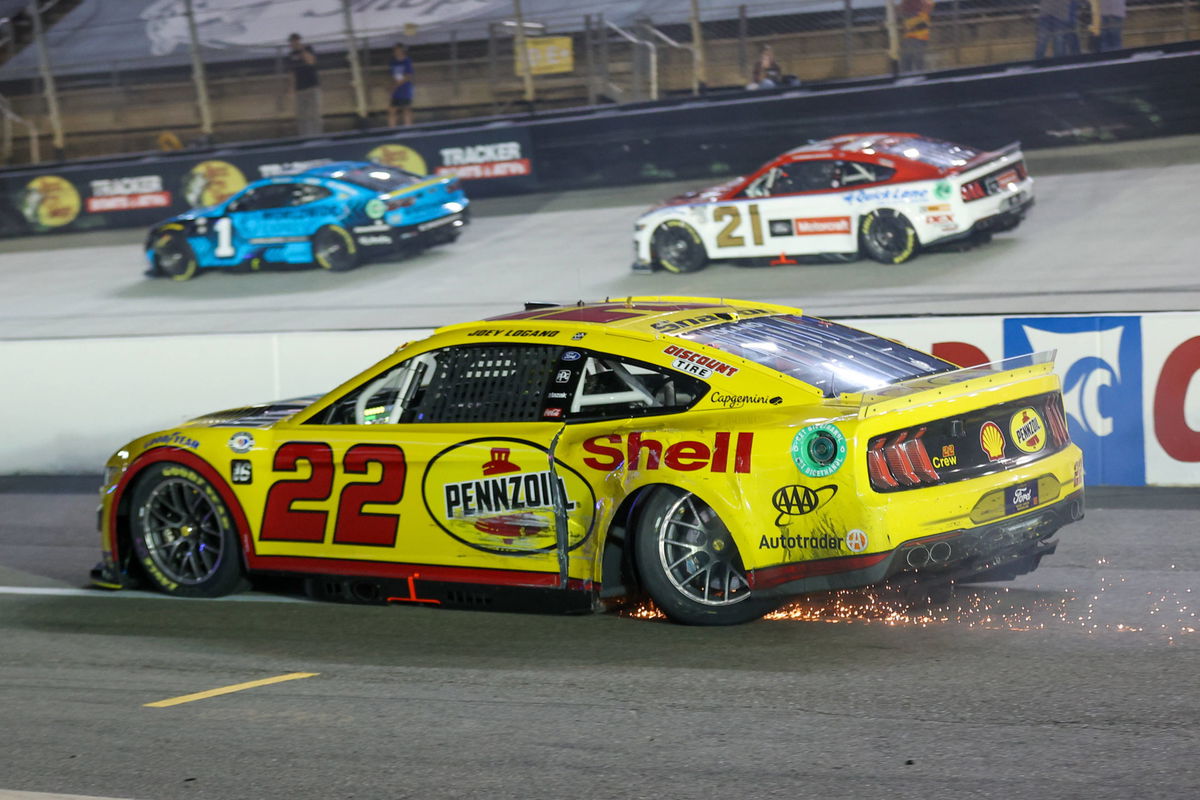
Imago
NASCAR, Motorsport, USA Bass Pro Shops Night Race Sep 16, 2023 Bristol, Tennessee, USA NASCAR Cup Series driver Joey Logano 22 after a crash during the Bass Pro Shops Night Race at Bristol Motor Speedway. Bristol Bristol Motor Speedway Tennessee USA, EDITORIAL USE ONLY PUBLICATIONxINxGERxSUIxAUTxONLY Copyright: xRandyxSartinx 20230916_tdc_bs1_0191

Imago
NASCAR, Motorsport, USA Bass Pro Shops Night Race Sep 16, 2023 Bristol, Tennessee, USA NASCAR Cup Series driver Joey Logano 22 after a crash during the Bass Pro Shops Night Race at Bristol Motor Speedway. Bristol Bristol Motor Speedway Tennessee USA, EDITORIAL USE ONLY PUBLICATIONxINxGERxSUIxAUTxONLY Copyright: xRandyxSartinx 20230916_tdc_bs1_0191
With the roar of their powerful engines, Joe Gibbs Racing kicked off its 2025 NASCAR Cup Series campaign with dominance. Despite a shake-up including Martin Truex Jr.’s retirement and the arrival of Chase Briscoe in the #19, Denny Hamlin, Christopher Bell, and Ty Gibbs delivered a scorching start. On the other hand, Joe Gibbs has often highlighted the uniqueness of NASCAR’s approach. “Our sport is unlike any other sport in that they were on the car today for three and a half hours, and you don’t get that in other sports,” said Gibbs in a 2024 press conference.
Watch What’s Trending Now!
But NASCAR’s relevance has become a hot issue in 2025 as ratings dip, its core fan base ages, and a younger audience shifts toward digital and alternative sports. The Pennzoil 400 race drew just 3.01 million viewers on FS1, a steep 31% drop from the previous year, as March Madness and NBA games dominated the airwaves. Veteran broadcaster Mike Joy warned that NASCAR isn’t attracting enough youth: “The fan base is getting older… We’re not attracting the younger fanbase that we need to move this sport forward.” So, while NASCAR is already concerned with these problems, one such insider from JGR has made cryptic comparisons over NASCAR’s racing style amid its relevancy debate.
ADVERTISEMENT
What happens when a racing boss gets reflective after a win
In a recent interview with Racing America, JGR President Dave Alpern offered a profound and uniquely insightful perspective on the very soul of NASCAR. Far from a conventional league, Alpern articulated a vision where the corporate identity of the sport isn’t merely a logo, but an embodiment of the racing machine itself. “At its core, I believe in what NASCAR is about,” said Alpern. “I love the idea that in our sport, the sponsor becomes the identity of the team. We’re not a patch on a jersey. The car becomes the actual identity of a brand.”
Consider the iconic bright red and white of the STP-sponsored cars driven by Richard Petty, a partnership that began in the 1970s and remains one of the longest-standing and most recognizable in motorsports history. Or think of the rainbow-colored #24 of Jeff Gordon, synonymous with Dupont, whose vibrant paint schemes became as much a part of Gordon’s legend as his four championships. That is what made Alpern’s unwavering pride in NASCAR palpable. “And we are the all-American racing series,” Alpern continued. “I don’t care what anyone says. You look at the ratings. What are they watching? They’re watching NASCAR. I love that.”
While viewership numbers for sports fluctuate, NASCAR consistently draws millions of eyes to its weekend races, particularly the Daytona 500, often dubbed “The Great American Race.” This isn’t merely about numbers, but also about the dedicated and passionate fanbase that transcends demographics. One of NASCAR’s most cherished and enduring attributes is its unparalleled fan access. “I love the access. That part hasn’t changed,” Alpern remarked. “The names and the faces and some of the people at NASCAR, at the teams have changed. But at its core, that’s what we’re about.”
ADVERTISEMENT
View this post on Instagram
Unlike many professional sports where athletes are often shielded from the public, NASCAR has historically embraced fan interaction. From the open garage areas in the past to the current fan zones and pre-race pit passes, fans can get remarkably close to the cars, the crews, and even the driver. Alpern candidly acknowledged that even a sport with such a clear identity can, at times, lose its way, emphasizing the importance of staying true to its roots. He gave an example, “I personally don’t like country music, but hey, we’re about country music, America, good times, fun,” said Alpern. “It’s a great sport. I love that. I think NASCAR does a really good job with that as well. I have a lot of confidence in them.”
ADVERTISEMENT
But perhaps the most striking and unconventional comparison Alpern made was to differentiate NASCAR from other sports leagues. ” I tell people we’re a little bit more like a band than a pro sports team,” said Alpern. “We don’t own our own arena. We show up and perform every week, and then we move on to the next. We’re like traveling circus, and then we move on, and then we perform somewhere else,” which is true. In the 2025 Cup Series schedule, teams crisscrossed the continent, starting at Daytona in Florida, rolling through Texas, Chicago’s downtown street course, and even staging a landmark race in Mexico City.
Ultimately, Alpern distilled the essence of the racing enterprise into a singular, unwavering objective: “And so a lot of things are out of our control, but in so much as we control it, we want to be the best. We just want to win.” Therefore, despite the heavy schedules and the myriad external factors, from weather delays to track conditions, the ultimate goal remains simple: victory. This forms both the core of JGR and NASCAR’s enduring appeal and distinctiveness in the broader sports landscape.
Top Stories
Another Almost Fatal Disaster Surfaces From Statesville Airport Amidst Ongoing Greg Biffle’s Crash Investigation
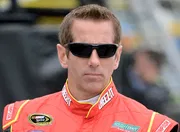
The Retirement Question – What Happens if Kyle Busch Fails in 2026?
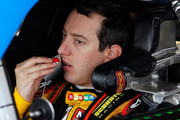
What Is NASCAR’s 5-Strike Rule That Could Change Its Future? Check All Details Here
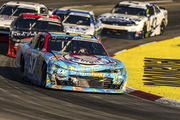
When NASCAR Didn’t Wait: Dale Earnhardt’s Injury Comeback Came With the Hot Seat of Zero Sympathy
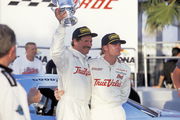
Dale Jr’s CARS Tour’s Powerful Greg Biffle Tribute Has NASCAR Fans Making One Emotional Demand
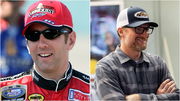
ADVERTISEMENT
Is NASCAR’s 2025 Cup Series already down to two teams?
JGR and Hendrick Motorsports have shaped the modern NASCAR Cup Series, combining for 19 championships and over 500 wins. But in 2025, their dominance has taken on a sharper edge, especially after Dover Motor Speedway. “We clearly see that the Hendrick Cars and the Gibbs Cars consistently are the top teams,” said Jeff Gluck on the Teardown podcast, with Jordan Bianchi nodding to how, “Hamlin… is suddenly kind of in the mix now.” With Chase Elliott now leading the points for HMS, and Hamlin sitting just behind Kyle Larson, it is shaping up to be a two-team war for the title.
Dover was a statement. Chase Elliott led 238 laps and won Stage 1. Bell won Stage 2 and challenged for the win before a late spin. Ultimately, Hamlin took the checkered flag. The top six finishers came exclusively from JGR and HMS, proving that on tracks both short and fast, their grip on the field is tightening. “So look at the standings, right?” said Gluck. “You… you still have three [Hendrick drivers], and now Chase Elliott… is taking over the points lead.”
While the likes of Team Penske, 23XI, and Trackhouse Racing have flashed speed, their wins have dried up. Since Nashville, it’s been all Gibbs and Hendrick. SVG’s road course mastery may be Trackhouse’s saving grace, but even his three wins aren’t shifting the narrative. As Bianchi noted, “I’m not feeling as confident about [other contenders]… HMS and JGR dominate the field.”
ADVERTISEMENT
ADVERTISEMENT
ADVERTISEMENT
ADVERTISEMENT

